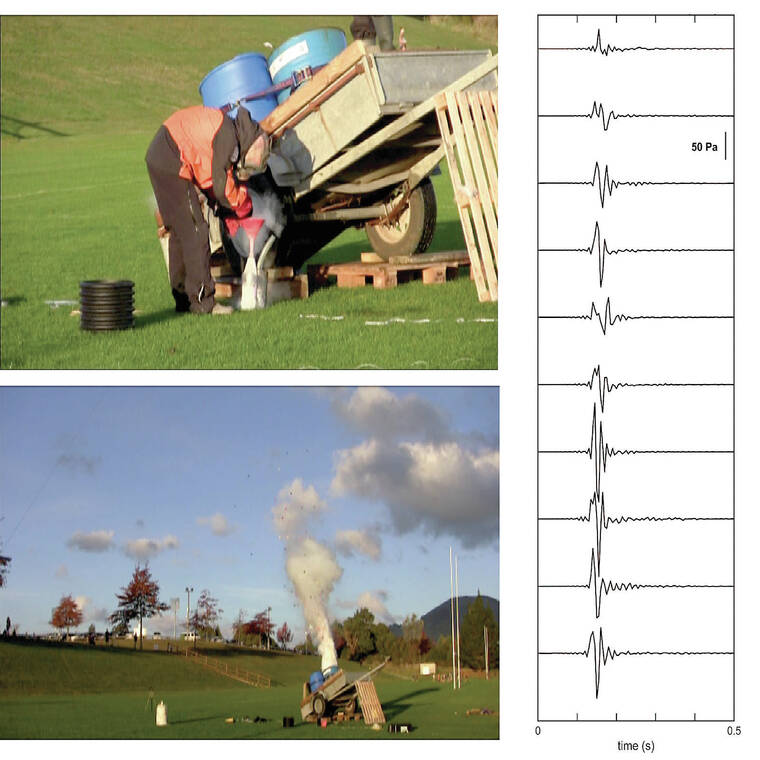The 1980 Mount St. Helens eruption in Washington State illustrated the hazards and impacts of lateral (ground-hugging) volcanic blasts on natural landscapes and human infrastructure. The eruption devastated hundreds of square miles and killed 57 people. In the more than forty years since, several additional laterally directed explosive eruptions have occurred world-wide.
A recent eruption at Ontake, Japan in 2014 showed the tragic impacts of laterally directed eruptions in near vent environments. But lateral eruptions at volcanoes are not only confined to the main eruption blast. Hot gas, ash, and mud can flow laterally from a mostly vertical eruption located in confining topography (like a valley) focusing ground-hugging volcanic flows (known as pyroclastic density currents) which may impact the near vent environment even for small eruptions. If a valley or other topography exists, these types of flows can move several miles from the eruption vent. In some cases, such events can produce mudflows, called lahars, which can be particularly dangerous even farther (tens of miles) from the source of the eruption.
Due to the devastating impacts these events can have on nearby areas, the global volcano monitoring community wants to improve the detection and characterization of hazards posed by explosive eruptions using automated sensors like seismometers and microphones for early warning systems.
A new preliminary field-scale experiment was recently completed by a U.S. and New Zealand research team, where the energy characteristics of a human-made ‘volcanic’ eruption was measured on a surrounding microphone ‘acoustic’ recording system. The experiment used a tiltable water cannon which was surrounded by pressure sensors like those used for volcano monitoring, both globally and here at the Hawaiian Volcano Observatory (HVO). The scientists wanted to determine if there were differences in the sound measured in the direction of the eruption blast, compared to the sounds measured behind the cannon. These differences may give scientists insight into the eruption processes and better understand the hazards associated with real ground-hugging eruptions.
The figure shows an example explosion from the inclined water cannon experiment. The barrel is comprised of a standard 55-gallon drum with one end open, filled one-third full of water at ambient temperature. A sealed soda-pop bottle filled with liquid nitrogen is dropped into the water. Because the liquid nitrogen is at a temperature of -196 degrees Celsius (-320 degrees Fahrenheit), it will expand in the warmer surrounding water. Shortly after the bottle is immersed, it rapidly bursts, producing a small, controlled explosion. Normally an explosion would expand in all directions, but because the bottle is at the bottom of an open-ended barrel, the energy is focused out of the barrel opening. The preferential direction of energy expansion and the explosion direction is then recorded on the surrounding sensors.
Each experiment was recorded with video cameras facing in three unique directions to document the blast direction and speed. Vertically directed blasts were found to have similar acoustic recordings on all the surrounding microphones. For more ground-hugging eruptions, the experiments suggest that the strongest blasts show higher frequency energy in the direction of the blast while lower frequency energy is recorded behind the blast source (in this case the cannon).
While more tests are required, the observations might reflect features of eruption blast dynamics that can be used as part of future eruption detection systems near hazardous eruption vents. The observational data may also have implications for hazardous mass flow events including pyroclastic-flows and lahar monitoring. While our Hawaiian volcanoes have fewer explosive eruptions in general, the observation results may be useful to understand the lateral migration of our Hawaiian fissure eruptions.
If you want to learn more about this experiment, check out this recent publication in Earth, Planets, and Space!
Volcano activity updates
Kilauea is no longer erupting. Its USGS Volcano Alert level is ADVISORY. Kilauea updates are issued daily.
Webcams show no signs of lava activity in Halema’uma’u crater, at the summit of Kilauea in Hawai‘i Volcanoes National Park. Summit tiltmeters have shown multiple deflation-inflation events over the past week. Seismicity is low. The sulfur dioxide (SO2) emission rate was most recently measured on March 21, when it totaled approximately 155 tonnes per day. For Kilauea monitoring data, see https://www.usgs.gov/volcanoes/Kilauea/past-week-monitoring-data-Kilauea.
Mauna Loa is not erupting. Its USGS Volcano Alert Level is at NORMAL. Mauna Loa updates are issued on the first Thursday of the month.
Webcams show no signs of activity on Mauna Loa. Seismicity remains low. Deformation rates show inflation somewhat above background levels, but this is not uncommon following eruptions. SO2 emission rates are at background levels. For Mauna Loa monitoring data, see: https://www.usgs.gov/volcanoes/mauna-loa/monitoring-data.
There were two earthquakes with 3 or more felt reports in the Hawaiian Islands during the past week: a M4.1 earthquake 52 km (35 mi) ESE of Naalehu at 7 km (4 mi) depth on March 26 at 6:36 p.m. HST, and a M3.9 earthquake 24 km (15 mi) WNW of Volcano at 4 km (2 mi) depth on March 23 at 5:04 p.m. HST.
HVO continues to closely monitor Kilauea and Mauna Loa.
Please visit HVO’s website for past Volcano Watch articles, Kilauea and Mauna Loa updates, volcano photos, maps, recent earthquake info, and more. Email questions to askHVO@usgs.gov.
Volcano Watch is a weekly article and activity update written by U.S. Geological Survey Hawaiian Volcano Observatory scientists and affiliates.



